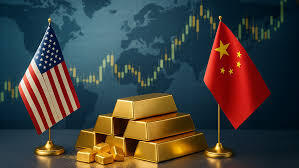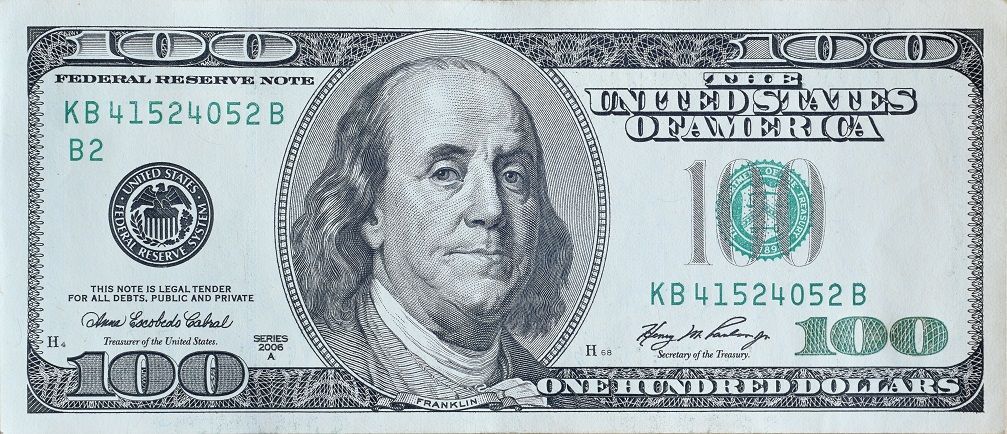

中國未雨綢繆將抵押在美的600 噸黃金運回中國 以免日後發生不測.
US President Trump has suspended reciprocal tariffs on other countries, but has raised tariffs on China to an unprecedented 125%, even threatening to delist Chinese stocks. China previously pledged to "fight to the end," but reports indicate Xi Jinping has approved a gradual divestment of US debt, with over 2,000 tons of gold already repatriated from New York vaults. The US and China are engaged in a "game of chicken," with only one side remaining to see who falls first..
.
.

.The Chinese are gobbling up gold despite its record-high price as U.S.-China trade tensions enter a fresh phase.
Newsweek reached out to the Chinese Foreign Ministry by email with a request for comment.
Geopolitical uncertainty is a key driver of gold prices, as investors turn to the metal as a safe haven.
This is especially evident in China, the worlds largest gold market, where prolonged stock market and property sector slumps have weighed on economic growth and fueled investor anxieties.
.
..
202504月份中國拋售500億美元的美國公債外,傳出將放在聯準會(Fed)紐約分行的2262噸黃金,要分批運回中國金庫保管。截至筆者發稿為止中國已經運回300 噸黃金.除此之外這300 噸的黃金就是當年美國壓迫中國如果要加入WTO. 就必須提供300 噸黃金作為擔保品,後來美國後續又強制要求中國再度提供300 噸黃金抵押,WTO.入會資格,換句話說總計中國提出600 噸黃金取得加入WTO.會員國的資格,顯示出美國的陰謀詭計如今中國強勢崛起成為世界第二大經濟體.
傳聞當時紐約曼哈頓商業區實施空前的安全保護措施並有500 名國民兵駐守各重要街頭巷尾.中國派出6 架 B-747.貨機接運黃金.
.自從美國總統川普2025. 再度發動貿易關稅戰中國與美國的雙方關係急速冷凍,美國總統川普暫緩實施各國的對等關稅,唯獨對大陸的關稅提高到前所未見的125%,甚至還不排除讓中概股下市。中國先前喊出「奉陪到底」,傳出習近平拍板逐步出清美債,已從紐約金庫運回超過2262噸黃金。美中上演「膽小鬼博弈」,就看誰先倒下。
中國的人民幣愈來愈值錢因為有足夠的黃金儲備發行現金票,美國則依賴印刷機瘋狂的印刷美元鈔票,騙取世界各國的資源,擾亂國際金融秩序.

.......
.
Chinas central bank has been buying physical gold to add to its reserves for at least the past three years - and theres growing speculation that the country may be purchasing even more of the metal in secret as part of a strategy to reduce its reliance on the U.S. dollar.
The ramp-up in gold purchases by the Peoples Bank of China (PBoC) began back in 2022 when Russia invaded Ukraine, Jan Nieuwenhuijs, gold analyst at Money Metals, told MarketWatch.
The West at the time froze Russias foreign-exchange reserves - the U.S. dollar and euro . That was the "moment the dollar was weaponized in a way never seen before, which scared foreign central banks and spurred them to buy record amounts of gold," he told MarketWatch.
When the West froze Russias foreign-exchange reserves in the wake of invasion of Ukraine in 2022, that was the moment the dollar was weaponized in a way never seen before, which scared foreign central banks and spurred them to buy record amounts of gold.Jan Nieuwenhuijs, Money Metals
In 2022, the PBoC reported the first increase in its gold reserves since September 2019, according to the World Gold Council. But that does not mean the central bank made no purchases of the precious metal for its reserve between those time periods. Thats because getting accurate data from China is widely known to be a challenge, as its government is known for its secrecy.
"Given how much gold its buying, its quite sensible for China to limit public disclosures where possible," said Stefan Gleason, president and chief executive at Money Metals. "After all, its not in the interest of any bona-fide buyer to take actions that make its purchases more expensive than they need to be."
Official gold purchases
Still, data reported by Chinas central bank does show overall additions to its gold reserves in recent years - and analysts say theres good reason for that.
The PBoC reported total gold purchases of 62 metric tons in November and December 2022, lifting its total gold reserves to over 2,000 metric tons for the first time, according to the WGC.
The following year, the PBoC was the largest single gold buyer among central banks, adding 225 metric tons to its gold reserves in 2023 to total 2,235 metric tons, the WGC said.
And in 2024, the PBoC reported buying 44 metric tons of gold, with 29 metric tons of that purchased between January and April. Then, it did not report any changes to the gold reserves until buying resumed in November, the WGC said. It held 2,280 metric tons of gold, representing 5% of total international reserves, at the end of 2024.
China and other nations, "especially those that are not close allies of the U.S., want to reduce their reliance on the U.S. dollar for reasons beyond mere diversification," said Money Metalss Gleason, with those nations having seen the U.S. "weaponize the dollar against both Iran and Russia."
Read: 5 reasons Trumps second term has been so good for gold: Its becoming a core asset class, CIO says.
The global trade war also suggests that America will be pulling back from foreign trade, so theres "less reason for other nations to hold so many dollars," he said.
Since the start of this year, the U.S. dollar index DXY, which measures the value of the U.S. dollar to a basket of foreign currencies, has fallen by more than 9% as of Wednesday.
A report from the WGC released Wednesday showed that Chinas official gold holdings have risen for eight months in a row, through June. The central bank reported a 2 metric-ton purchase in June for total gold holdings of 2,299 metric tons.
When asked if the PBoC may be buying more gold than its disclosing, Joe Cavatoni, market strategist at the WGC, acknowledged that there is ongoing discussion in the market about "whether the PBOCs reported purchases fully capture its activity."
However, the WGC has found that "China regularly provides reporting in line with the rules," he said. In some instances, it may be delayed, but it is "always adjusted to reflect the activity."
The WGC works with Metals Focus to aggregate data reported by the PBoC, in accordance with the International Monetary Fund guidelines, said Cavatoni. The WGC is "confident" that Metals Focus has "accurate numbers quarterly," he said.
Still, Cavatoni admitted that there is "always the case that maybe more is going on than is reported."
Covert transactions?
Indeed, its possible theres more to the story of the PBoCs gold-buying than meets the eye.
Nieuwenhuijs told MarketWatch that he believes the PBoC, "in reality," held 5,065 metric tons of gold in its reserve at the end of 2024. That compares with the central banks reported holdings of 2,280 metric tons in 2024, according to WGC data.
Nieuwenhuijs said he based his estimate on "unreported purchases" by central banks, as disclosed by the World Gold Council in its quarterly data. The WGC offers estimates for gold purchases that are not reported by central banks, using public data, trade statistics and other sources.
"China [is] importing much more gold than what is sold in the private market through the Shanghai Gold Exchange, and what industry insiders have shared with me over the years," Nieuwenhuijs said.
Direct gold exports from the U.K. to China "must reflect PBoC purchases," for one, because they continue to be elevated even when gold on the Shanghai Gold Exchange (SGE) trades at a discount to London, he said.
He explained in a November 2024 article that when the SGE trades at a steep discount, gold imports into the domestic market are not bought by the private sector. It would not make sense for a bank to import gold to Shanghai to sell at a loss, he said.
Nieuwenhuijs brought up the idea that China was covertly buying gold for its central-bank reserves as far back as 2023, in an article for the Gold Observer.
His colleague Gleason at Money Metals pointed out that one of the "most compelling pieces of circumstantial evidence" that Nieuwenhuijis has uncovered is export/import data showing large gold flows into China at times when Shanghai was actually trading at a discount to London.
"In that environment, there would be no market incentive for big imports into China when gold is plentiful [and] cheaper locally," he said. "If large amounts of 400 [ounce] bars are exported to China from London at that time, it implies institutional buying for strategic reasons."
The power of gold
Whether Nieuwenhuijss findings are true or not, Chinas interest in gold to build its central bank reserves is undeniable. So is the countrys ability to move the gold markets, as the worlds biggest producer of the metal, and one of its largest consumers.
Bart Melek, head of commodity strategy at TD Securities, said China would stock up on gold mainly to diversify its $3.3 trillion foreign-exchange reserve, of which only 6.7% is gold. This is to "protect against the erosion of purchasing power of the U.S. dollar," as China fears that the U.S.s $37 trillion debt will "grow unsustainably quickly."
So "purchasing-power preservation, mitigating sanction risk and adjusting for less trade with the U.S.," as U.S. tariffs lead to less need for U.S. dollar holdings, are key reasons why China would want to move away from reliance on the greenback, Melek told MarketWatch.
Gold provides an asset which has "no counter-party risk, has intrinsic value and is an automatic inflation hedge," he said. Global central banks now hold 20% in gold in their foreign exchange reserves - the highest since the Bretton Woods monetary management system, said Melek. The pact signed in 1944 established a new exchange-rate system, pegging foreign currencies to the U.S. dollar, with the dollar, in turn, pegged to gold.
Nieuwenhuijs said gold is the "only asset that can replace the dollar as the prime world reserve asset" because, in part, it is liquid and has been used as a reserve asset for thousands of years.
Even so, gold hasnt been able to climb to fresh record highs. Prices for the most-active futures contract (GC00) had traded as high as $3,509.90 on April 22, marking a record intraday high on Comex.
The Federal Reserves postponement of interest-rate cuts was the "excuse gold needed to take a breather and consolidate its massive gains over the past year," said Money Metalss Gleason.
The precious metal, however, is likely to head higher again.
"Putting aside a black-swan event like a war escalation, new weakness in the stock and bond markets and/or a lurch toward a dovish Fed are the most likely catalysts for higher gold prices," said Gleason. Fed Chairman Jerome Powells days may be numbered - "and so is his stance against further rate cuts."
..